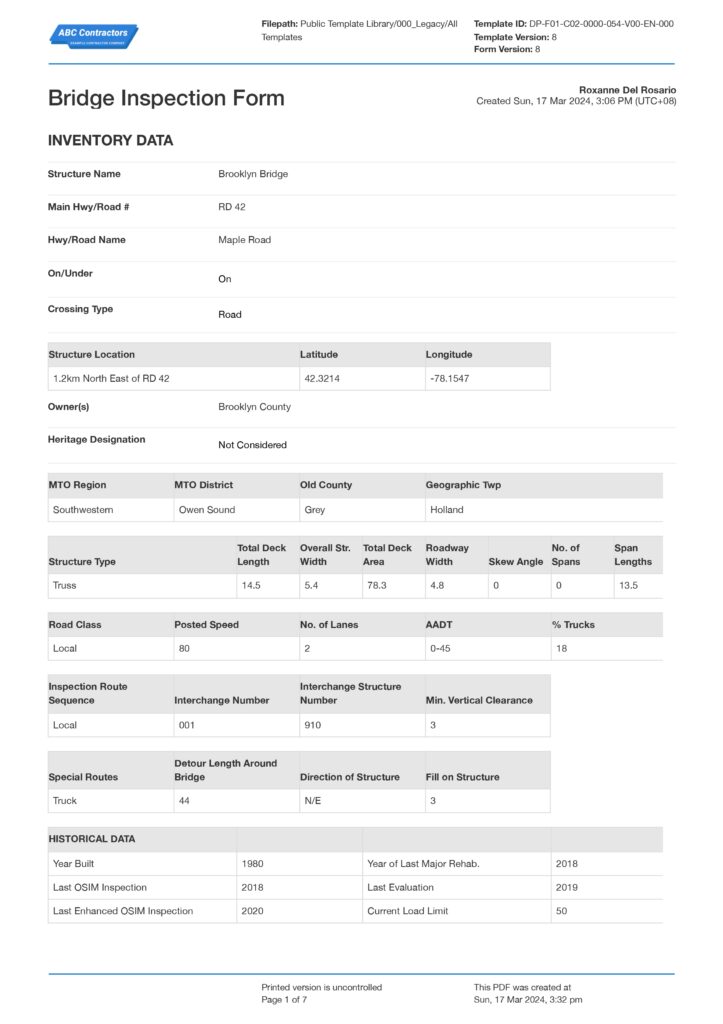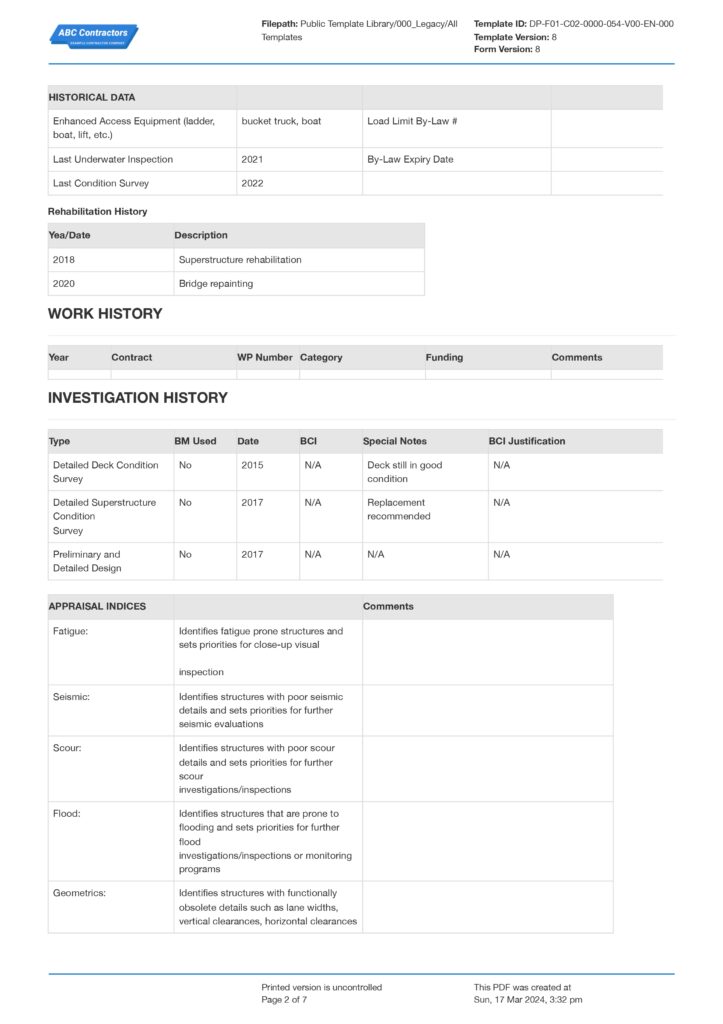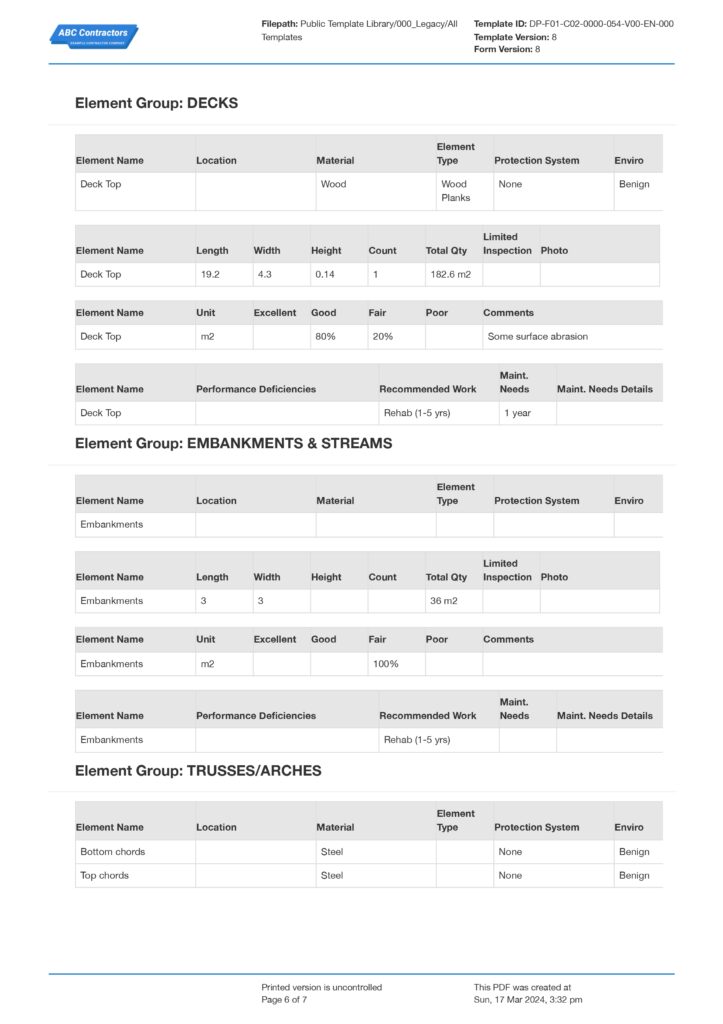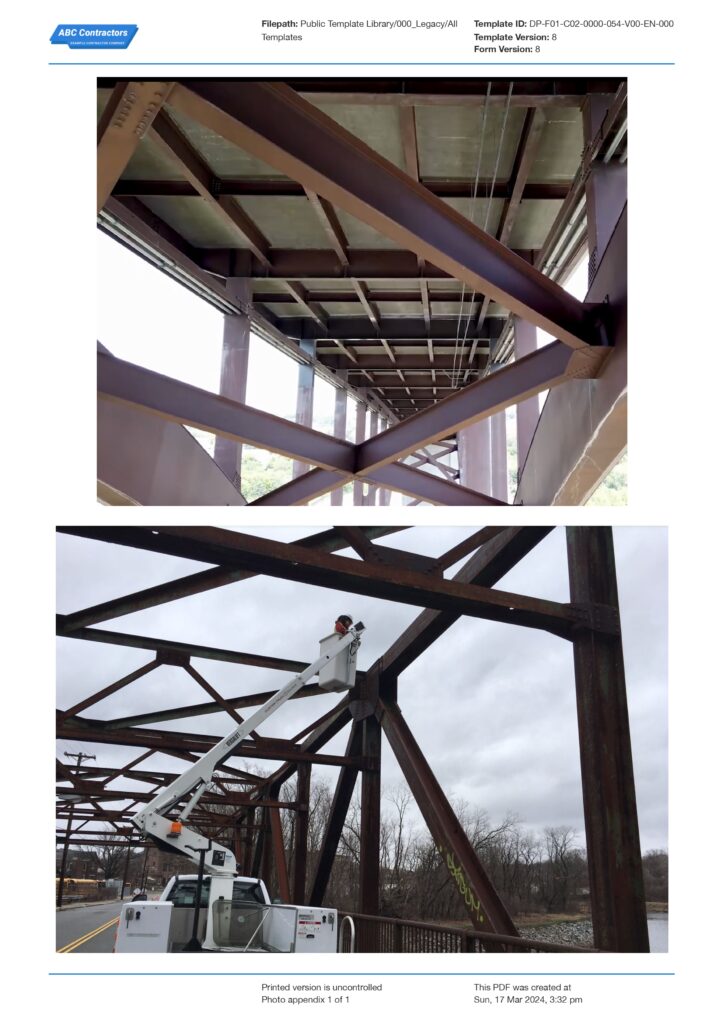Dashpivot Article – Bridge Inspection Requirements

Bridge Inspection Requirements
Why are Bridge Inspection Requirements Important?
Every year there are thousands of bridges being built all over the world that connects and enables people to cross a physical obstacle and pass on top of a huge body of water or land. Building these bridges as well as maintaining calls for strict implementation and huge financial investments as the safety of the general public when traveling to bridges relies on how the bridge is well made in structure and serves its purpose and function. Bridges are inspected periodically depending on the necessity of the bridge or what is called levels of inspection needed but the purpose is the same, it is to ensure that the structure of the bridge can avoid accidents of road users and costly repairs. In this article, we will go into detail on the different bridge inspection requirements, and wrap up showing you how you can streamline your bridge inspection while making your reporting more convenient and accurate.
The bridge inspection requirements can vary according to each country and this is primarily related to the national road laws that regulates and ensures quality bridge safety management.
Depending on the level or type of inspection, it is a general requirement for inspections to be hands on or close up within arm’s length to closely see, properly measure, and in some cases photograph the condition of the bridge.
What are the Essential Bridge Inspection Requirements?
A bridge inspection is typically conducted using a standardised bridge inspection report form, which is essential for assessing the structural integrity and safety of bridge infrastructure.
This form is designed to comprehensively address the essential bridge inspection requirements ensuring all necessary parameters are evaluated to maintain operational standards and safety.
This section will detail these bridge inspection requirements in full, and analyse the critical elements and considerations that the inspection process must encompass to uphold the structural and functional integrity of bridges.
Bridge inspection requirement - Inventory Data
The Inventory Data section establishes the framework for bridge inspection requirements by capturing essential identifiers and structural characteristics that define the bridge, such as its name and precise geographical coordinates. These details help position the bridge within the infrastructure network and include integration into the road network through main highway or road numbers, specific road names, and its orientation (over or under other structures).
This section records the type of crossing—essential for understanding the bridge’s function and the nature of traffic it supports—and notes ownership, heritage designations, and jurisdictional information like the MTO region and district. These are crucial for legal, preservation, and maintenance coordination.
Structural specifics documented include dimensions like total deck length, overall structure width, and roadway width, along with the skew angle, number of spans, and their lengths. These parameters are vital for structural analysis and strategy determination for inspections, helping evaluate the bridge's traffic capacity and type, indicated by metrics such as AADT percentages and lane numbers.
Additionally, the structural type (truss, beam, or other) is specified to guide inspection techniques and maintenance needs. Further details like road class, posted speed limits, inspection route sequence, interchange numbers, detour lengths, the direction of the structure, and the presence of structural fills aid in precise and systematic inspection planning.
Historical Data
The Historical Data section logs important past information and changes the bridge has undergone, essential for assessing its current condition and planning for its future needs. It includes the construction year and major rehabilitations to provide insight into the bridge's longevity and the extent of significant maintenance performed.
It documents the dates of the last routine and any specific enhanced inspections to track the bridge’s maintenance history and compliance with safety standards. The current load limit reflects the maximum weight the bridge can support, a crucial element for safe load management.
This section also includes records of specialised inspections like underwater surveys critical for bridges over waterways. These inspections identify potential issues like scouring or underwater damage that could compromise the bridge’s foundation. The enactment and expiration dates of related by-laws or regulations are noted to ensure compliance with current practices.
Additionally, the rehabilitation history lists years and types of specific refurbishments such as superstructure reinforcement or repainting, highlighting the maintenance efforts to preserve the bridge’s functionality and safety.
Work History
The Work History section provides a comprehensive record of all maintenance, repair, and construction activities on the bridge, crucial for understanding past work and planning future interventions and budgets.
Each entry includes the year the work was performed, the work category (general maintenance, structural reinforcement, emergency repairs), and the work package number, which links to detailed project documentation. This information is vital for financial tracking and accountability.
Additionally, this section might include comments on the work scope, implementation challenges, and any deviations from the planned process. These notes are invaluable for providing context and precedent for how similar situations have been managed in past inspections and works.
Investigation History and Appraisal Indices
The Investigation History and Appraisal Indices section of the bridge inspection form encapsulates all detailed assessments, investigative surveys, and strategic evaluations focused on various structural components and risk factors associated with the bridge.
The Investigation History records each specific investigation conducted, ranging from detailed deck and superstructure condition surveys to preliminary and detailed design evaluations. For each investigation, the form notes the type, benchmarks used, date conducted, Bridge Condition Index (BCI), and any special notes that highlight significant findings. The BCI Justification provides reasons for the ratings given, crucial for assessing the bridge’s condition and safety.
The Appraisal Indices assesses the bridge against several critical indices which are vital for determining structural health and operational safety:
- Fatigue: Evaluates the endurance of bridge components under repeated stress cycles and identifies areas needing close-up inspections.
- Seismic: Assesses the bridge’s ability to withstand seismic events, suggesting priorities for further evaluations.
- Scour: Focuses on vulnerabilities of the bridge’s foundations to erosion at piers and abutments, critical during floods.
- Flood: Determines the bridge's resilience against flooding, particularly the effectiveness of its drainage systems in managing high water levels.
- Geometrics: Reviews the design for functionally obsolete features, such as inadequate lane widths and vertical clearances, affecting traffic safety and flow.
- Barrier: Compares existing barriers against current code requirements to identify safety deficiencies.
- Load Capacity: Ranks the bridge based on its load-carrying capacity using current standards, identifying at-risk structures under typical or increased loads.
Additional Investigations Required as Part of Bridge Inspection Requirements
The Additional Investigations Required section outlines specific surveys and assessments needed beyond routine inspections to ensure the bridge meets all safety and performance standards. This part of the form specifies various types of investigations that may be necessary depending on the bridge’s condition, material composition, and environmental exposure.
- Material Condition Survey: Assesses the condition of materials used in bridge construction, such as concrete and steel, which are critical for determining the overall health of the structure.
- Non-Destructive Delamination Survey of Asphalt-Covered Deck: Utilizes techniques that do not damage the bridge's surface to identify separation layers within the asphalt, which can compromise the deck's integrity.
- Concrete Substructure Condition Survey: Evaluates the condition of concrete elements in the substructure, including piers and abutments, to identify cracks, spalling, or other deterioration that could affect the bridge’s stability.
- Detailed Coating Condition Survey: Checks the status of protective coatings on metal elements to prevent corrosion, essential for extending the lifespan of the bridge.
- Detailed Timber Investigation: Focuses on wooden components of the bridge, examining them for signs of rot, insect damage, or weathering that could weaken the structure.
- Post-Tensioned Strand Investigation: Inspects the condition of post-tensioned strands, which are vital for the structural integrity of segmental bridges, to ensure there is no corrosion or loss of prestress force.
- Underwater Investigation: Conducts inspections of submerged parts of the bridge, crucial for detecting scour, sediment build-up, or other underwater issues that could threaten the foundation.
- Fatigue Investigation: Analyzes areas susceptible to fatigue from repeated stress, important for preventing sudden failures of bridge components.
- Seismic Investigation: Assesses the bridge’s ability to withstand seismic events, ensuring that it can resist earthquake forces based on its design and construction.
- Structure Evaluation: A comprehensive assessment of the bridge's overall structure, integrating findings from other surveys to evaluate its ability to continue safe operation.
Overall Structure Notes
The Overall Structure Notes section consolidates observations, evaluations, and recommendations from the entire inspection process into actionable insights. This section is pivotal for determining immediate and future interventions required to maintain or enhance the bridge's safety and functionality.
- Recommended Work on Structure: Specifies the type of work necessary based on the inspection findings, such as repairs, reinforcements, or complete replacements. This is determined by the severity and nature of any defects found during the inspections.
- Timing of Recommended Work: Provides timelines for when the recommended interventions should be initiated. This scheduling is crucial for planning and resource allocation, ensuring that repairs are carried out in a timely manner to prevent further deterioration or potential safety hazards.
- Date of Next Inspection: Indicates when the next inspection is due, based on the current assessment and the regular inspection cycle. This helps in continuous monitoring of the bridge's condition and the effectiveness of completed repairs.
- Maintenance Needs: Lists specific maintenance activities required to address identified issues. These activities can range from minor adjustments and cleaning to more significant structural repairs, all aimed at extending the bridge’s service life and optimizing its performance.
- Suspected Performance Deficiencies: Outlines potential or existing deficiencies in the bridge’s structure that could impair its functionality or safety. This includes problems like load capacity limitations, excessive deformations, or material degradation that need to be monitored or rectified.
Element Data
The Element Data section is critical for detailing the specific condition and requirements of different structural components of the bridge. This comprehensive analysis helps in pinpointing areas needing maintenance, repair, or monitoring, facilitating targeted interventions that enhance the bridge's safety and longevity.
- Abutments: This subsection includes data on abutment walls, specifying their location, material composition, type (such as conventional or counterfort), protection systems in place (like coatings or cathodic protection), environmental conditions affecting them, dimensions, and their current inspection status. Any observed deficiencies, required work, and ongoing maintenance needs are thoroughly documented.
- Barriers: Focuses on railing systems and other barrier types, detailing the materials used (steel, concrete), the design type (flex beam, jersey, guardrail), and their environmental exposure. Dimensions, the extent of any damage, performance deficiencies, and urgent maintenance or replacement needs are also recorded.
- Beams/Main Longitudinal Elements: For main load-carrying elements like beams and girders, information on material types (steel, prestressed concrete), structural configuration (I-beam, box girder), protection systems, and current condition ratings are included. Details on any identified issues, such as corrosion or structural fatigue, and the corresponding remedial actions are specified.
- Decks: This subsection examines the deck structure, noting the type (concrete slab, orthotropic steel), materials, dimensions, and any protective measures like waterproofing layers. Condition assessments indicate the presence of issues like cracking or delamination, with notes on needed repairs to preserve integrity and functionality.
- Embankments & Streams: Details conditions of embankments, slopes, and adjacent watercourses, crucial for assessing risks like erosion or undermining. Material stability, vegetation cover, and any signs of distress are evaluated to determine necessary erosion control measures and reinforcement strategies.
- Trusses/Arches: For bridges with truss or arch configurations, specifics on the elements such as top chords and bottom chords include material details, protective measures, environmental challenges, and structural evaluations. Maintenance recommendations focus on critical stress points and connections prone to degradation or failure.
Below is an example of a bridge inspection form that contains all the necessary sections:

Use and customise bridge inspection checklist report forms for free
Comply with bridge inspection requirements with customisable forms
You can use the above form and framework for your next bridge inspection requirements, as it guides you through all of the critical components we covered in the article.
This specific document comes ready built with the below sections:
- Comprehensive Data Collection: It includes extensive sections for Inventory Data, Historical Data, and Work History, ensuring all aspects of the bridge’s structure and maintenance history are well-documented.
- Detailed Inspection Framework: The form provides a systematic approach for documenting new inspections within the Field Inspection Information section, which captures detailed environmental conditions, the type of inspection, equipment used, and personnel involved.
- Appraisal Indices: This section introduces criteria for evaluating the bridge against specific safety and integrity indices such as Fatigue, Seismic, Scour, Flood, Geometrics, Barrier, and Load Capacity, which are critical for assessing the bridge’s vulnerability to various structural and environmental challenges.
- Focus on Specific Investigations: The form mandates recording findings from specialized investigations like underwater inspections or material condition surveys, which are crucial for assessing areas that regular inspections might not cover adequately.
- Element-Specific Analysis: In the Element Data section, it breaks down the inspection data by individual structural components—such as abutments, decks, and beams—providing detailed assessments of each for targeted maintenance and repair.
- Maintenance and Repair Recommendations: The Overall Structure Notes section provides summarised recommendations and maintenance needs, which are essential for planning future actions to address identified issues.
- Regulatory Compliance: By detailing load limits, compliance dates, and specific deficiencies, the form helps ensure that the bridge remains compliant with current safety regulations and operational standards.
Improve your bridge inspection reports with digital applications
Bridge inspection report checklists collect a large volume of data, which is necessary to ensure that bridge inspections address all the key bridge inspection requirements.
However, using individual forms for the bridge inspection can create some issues.
Individuals forms can be misplaced or overlooked, especially when they are multiple pages long, resulting in document and information loss. This can affect regulatory compliance and lead to legal consequences in the event of a safety incident.
Lengthy inspection report checklists are also difficult to access. All stakeholders will require a copy and will need to distribute it to their team members. This may result in delays if there are access issues.
This is why many companies now use a bridge inspection software to manage their bridge inspections. With an application users can create, complete, and access all their bridge inspections from any location with a digital device.
All inspections are stored in a central register, preventing them from being lost or misplaced. Internal and external stakeholders can access any relevant inspections at all times as well, ensuring that everyone is able to view the document for their purposes.

Safety Audit Checklist template
Conduct and manage your safety audits like a pro using a smart digital audit template.

Facility Inspection Checklist template
Use and customise this facility inspection checklist to suit your general facility inspections and more safety or other area focused efforts.

Field Level Risk Assessment template
Run this Field Level Risk Assessment template before specific tasks to keep things safe and compliant.







